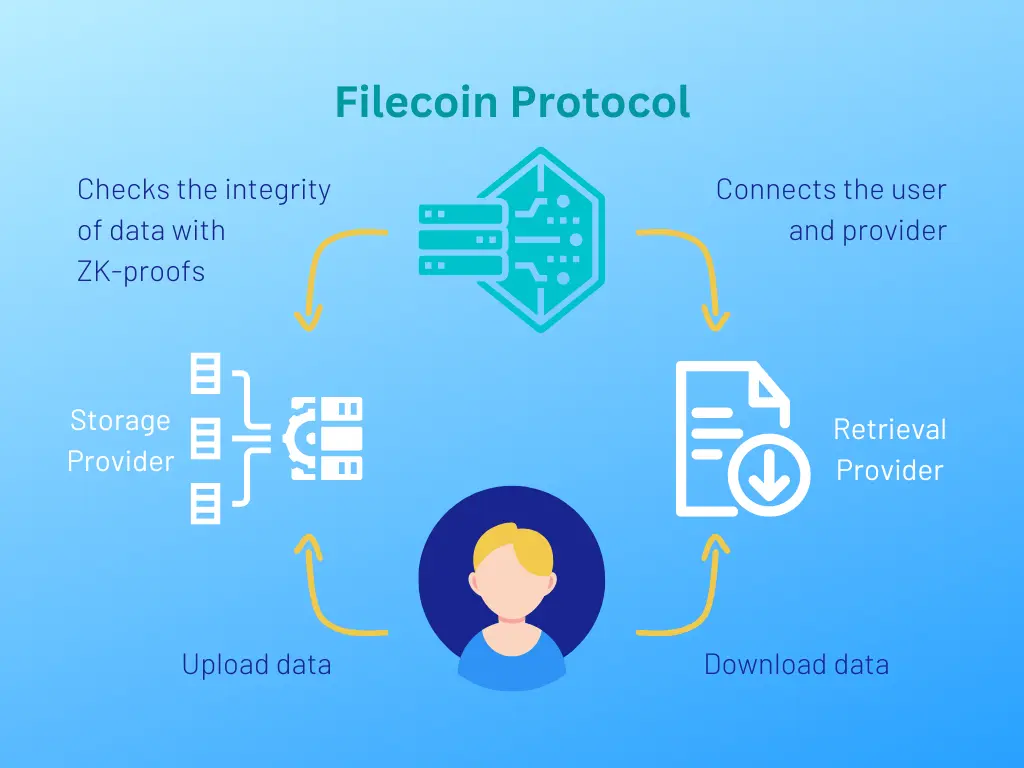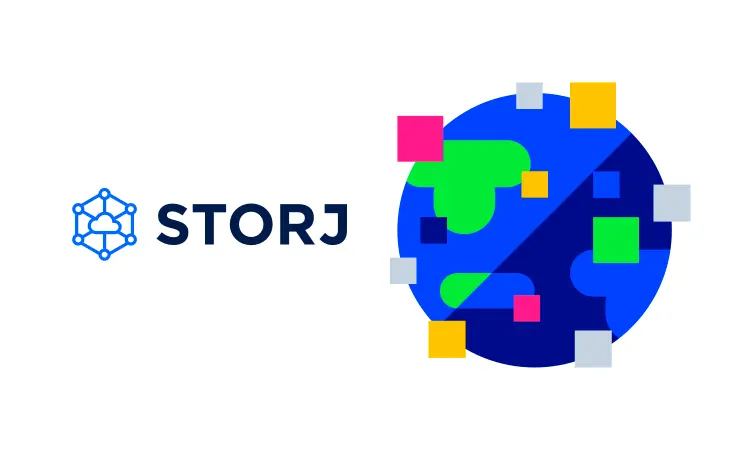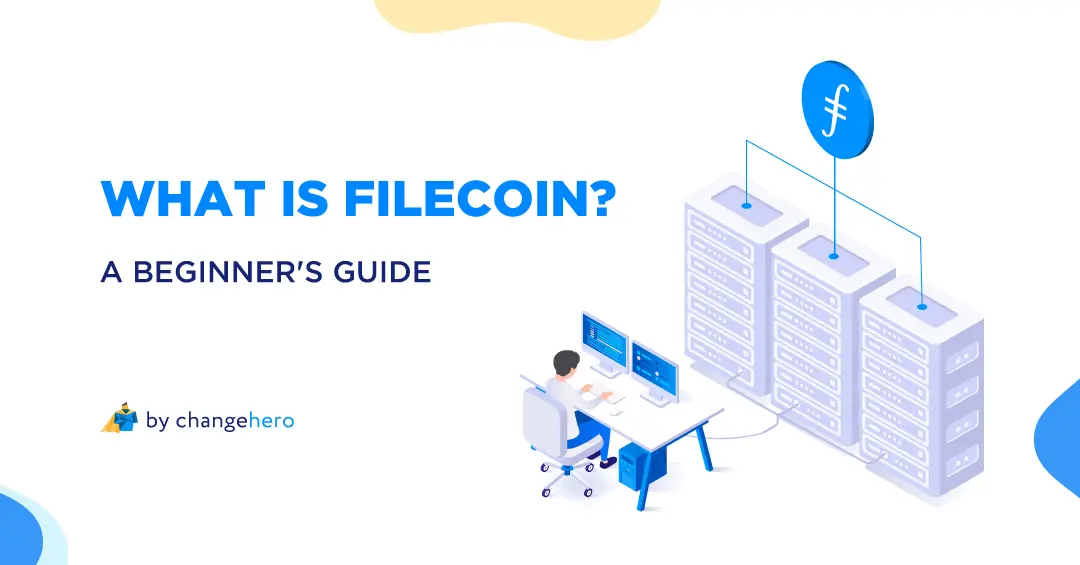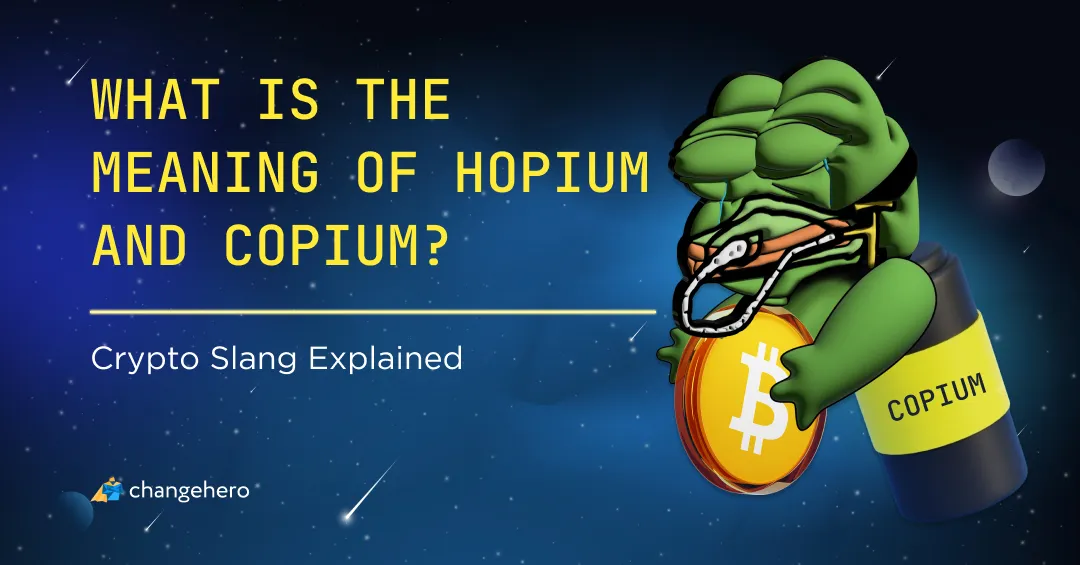In Web 2.0, data storage is dominated by corporations like Amazon and Microsoft, but it is far from the only way. Decentralized file storage and sharing protocols like IPFS and BitTorrent make it more fitting for Web 3.0. However, IPFS comes with a whole incentivized ecosystem layer that acts like an open marketplace for storage and download deals — that is Filecoin. In this guide, we introduce the Filecoin network and storage market, as well as its crypto token FIL.
Key Takeaways
- Filecoin is a decentralized storage network intended to “store humanity’s data” in an efficient manner.
- It raised $257 million from ICOs in 2017 and initially aimed to start in mid-2019. Filecoin’s mainnet launch was moved to October 2020.
- The project had been formally described in 2014 by the creator of the Interplanetary File System, a peer-to-peer network in which people pay for data backup and delivery services in FIL.
Filecoin’s Decentralized Storage Network And How It Works
Centralized data storage is convenient and widespread but has major flaws: verification of the integrity of the data stored is not easy. You can entrust an Amazon server with storing some of your data but there is no telling if it gets unretrievable.

Filecoin attempted to solve the problem by introducing a decentralized storage network that acts like an open marketplace. To have your data stored, first, you would need to make a deal with the storage provider. Its conditions specify the duration of storage and the provider’s reward, among other things.
Filecoin keeps tabs on the integrity of stored data with the use of zero-knowledge proofs. If the storage fails, or the provider deletes the data entrusted to them, it slashes the provider’s stake in FIL.
To download the data, users make deals with other network participants: retrieval providers. To keep these kinds of deals as fast as possible, they are carried out off-chain via payment channels.

Proof-of-Replication and Proof-of-Spacetime
Filecoin designed a consensus algorithm that does not rely on Proof-of-work, which sets it apart from the competition. The contribution of providers is measured not in computing power but in provided storage space, and it has to be accounted for accordingly.
Proof-of-replication (PoRep) is a specification of the proof-of-storage algorithm. It ensures that the provider is not storing the user’s data twice, and makes storage verifiable and reliable. It also enables Proof-of-Spacetime (PoSt), which outlines and proves not only the fact of data storage but also its duration. Both of these algorithms make Filecoin’s design of an open storage market work.
A Brief History Of Filecoin
The Filecoin project originates in 2014 as a motivation layer to the peer-to-peer file network, Interplanetary File System (IPFS). Both of them were described by Juan Benet, with the Protocol Labs members’ contributions. Benet founded Protocol Labs in 2014.
The first steps to bring Filecoin into reality took place in 2017 when Protocol Labs held a presale and Initial Coin Offering (ICO). At that time, the Filecoin protocol existed only on paper but it still raised $52 million from advisors and $153 million in a public sale. Nevertheless, it would not be two more years until devnets and testnets started launching.

After the lengthy research and development stage, the Filecoin network mainnet was ready to launch in October 2020. Along with the Protocol Labs, its progress is overseen by Filecoin Foundation.
What is FIL crypto?
To give providers an incentive and make sure they behave fairly, the Filecoin protocol uses a native token FIL. The max supply is 2 billion tokens, created at the genesis of the blockchain. 70% of it was locked to be distributed as “mining” rewards.
| Circulating Supply | 326,690,989 FIL |
| ICO Price | $1.91 per FIL |
| Block Reward | 19.38 FIL |
| Typical Hold Time (per Coinbase) | 18 days |
The native Filecoin token is among other things a gas token. The fee mechanics in Filecoin were designed after Ethereum’s EIP-1559, which divides a fee into the burnable base fee and a miner tip. Consequently, the more FIL is transferred, the higher the deflationary pressure.
What is FIL mining?
There are two sources of revenue for participants in the Filecoin network. One is supply revenue: the FIL earned through service provision and FIL staking. The other is protocol revenue, in other words, network fees. Currently, FIL is being distributed to service providers as an incentive, which can be called mining, as you need to contribute storage capacity to earn FIL. The more storage you provide, the higher the probability of adding a block to the chain.
FIL mining is not the same as Bitcoin mining, because Filecoin does not use Proof-of-work. To “mine” Filecoin, an 8-core CPU, a high-grade GPU, at least 128 GiB of RAM, and 100 TiB of storage are recommended. The required specifications are rather high but at the same time, Filecoin is ASIC-resistant.
How To Use FIL?
As FIL is a native token of the Filecoin protocol, some of its use cases are typical for this kind of network. However, the crypto-economic design of the Filecoin network gives it more utility.
- Transaction fees for all users;
- Staking for storage providers;
- Securing storage deals and paying fees for storage;
- Paying retrieval fees to providers when downloading.
Filecoin And Similar Projects
Filecoin vs Siacoin

Filecoin is not a novel idea. By the time Protocol Labs held an ICO, Sia had been active for two years already. While Filecoin was building an improved solution to decentralized file storage, Sia can be thought of as an original implementation.
Sia’s co-founder David Vorick described it as a storage protocol built after the Bitcoin proof-of-work model. It, too, has Siacoin (SC) to monetize the data provision service. Since the consensus in Sia is achieved by proof-of-work, it means that miners that amass computing power but do not necessarily provide actual storage dominate the network. Filecoin is also more reliable: if a provider drops off Sia with a piece of users’ data, it means the users themselves have to amend the lost files.
Filecoin vs Storj

Another contemporary of Filecoin is Storj, a decentralized cloud computing and storage platform. On an abstract level, both networks work similarly, but unlike Filecoin, Storj pulls it off while running on top of Ethereum. Incidentally, its native cryptocurrency STORJ is also an ERC-20 token.
Is Filecoin Controversial?
There are a few things to keep in mind about Filecoin’s history, as well as a couple of episodes of the Twitter drama. Twitter users have tried to understand, to no avail, why did the Filecoin blockchain start with a number associated with hate speech.
In 2020, Juan Benet beefed with Justin Sun on Twitter over the BitTorrent File System rebrand. Both of the founders did not mince any words regarding their rival products, with Sun pointing out that both IPFS and Filecoin were in development hell for years.
Experts have criticized Filecoin for launching with excessive amounts of venture capital. In the crypto industry, where “fair launch” is a thing and Ethereum only needed $18 million to start, raising $100 million in VC funds raised some eyebrows.
Despite the fact that Filecoin advertises itself as a decentralized file storage network, in practice, it turned out to be not so unstoppable. In September 2022, Ethereum infrastructure provider Infura suffered outages, which caused Filecoin API to go down for about an hour twice. This is far from the only example of the industry’s dependency on a single infrastructure provider.
What Is The Future Of Filecoin?
Filecoin has already onboarded notable clients with large datasets: New York City, Opensea, the USC Shoah Foundation, UC Berkeley, GenRAIT, and Ewesion. The latter three are using data storage providers that leverage the Filecoin blockchain to store datasets of critical importance for human history and science.
Filecoin’s network rewards depend on the active storage deals and storage capacity. It reached an all-time high of 16.7 EiB (or 19,253,789,133.5 GB) in Q2 2022 and remains roughly at this level even after the crypto market downturn.
At the moment, a large-scale update in the form of Filecoin Virtual Machine is being rolled out incrementally. User-defined smart contracts for storage markets can further improve the landscape of Filecoin’s ecosystem. The full launch of FVM is slated for 2023.
Now that we have run down the Filecoin fundamentals, let’s move on to a couple of pieces of practical advice.
What Wallet to Use for FIL?
Official docs recommend dedicated wallets: web wallet Glif and Filecoin client Lotus. These are the perfect tools to manage FIL only but may be unwieldy for a casual crypto user.
Filecoin (FIL) is a rather popular blockchain, so plenty of multi-coin wallets like Metamask and Trust Wallet support it. For full access to handy features, the ChangeHero team recommends Exodus.
How to Exchange FIL on ChangeHero?
If you want to exchange your crypto for FIL and need a refresher on how swapping crypto on ChangeHero works, we’re here to help:
- Choose the currencies on the home page, amounts, and the type of exchange. Provide your wallet address in the next step and check the details;
- Double-check the provided information, read and accept the Terms of Use and Privacy Policy;
- Send the sum of the cryptocurrency for the swap in a single transaction. In Fixed Rate transaction you have 15 minutes before it expires;
- Sit back and relax. At this step we are doing all the work: checking the incoming transaction and doing the exchange as soon as it arrives;
- As soon as the exchange has been processed, your FIL is on its way to your wallet. And so, the transaction is finished!
If you ever run into any issues during your swap, our support specialists are always available to help you in the chat or through the email: [email protected].
Conclusion
Admittedly, at this stage, a decentralized storage network like Filecoin might be not as convenient as established server providers. However, having an alternative that is resistant to downtimes and censorship, among other things, is of utmost importance. Filecoin offers a bonus in the form of an open market on top of it all.
If you enjoyed this beginner’s guide, check out our blog for more. Follow ChangeHero on Twitter, Facebook, Reddit, andTelegram for daily updates and more content.








